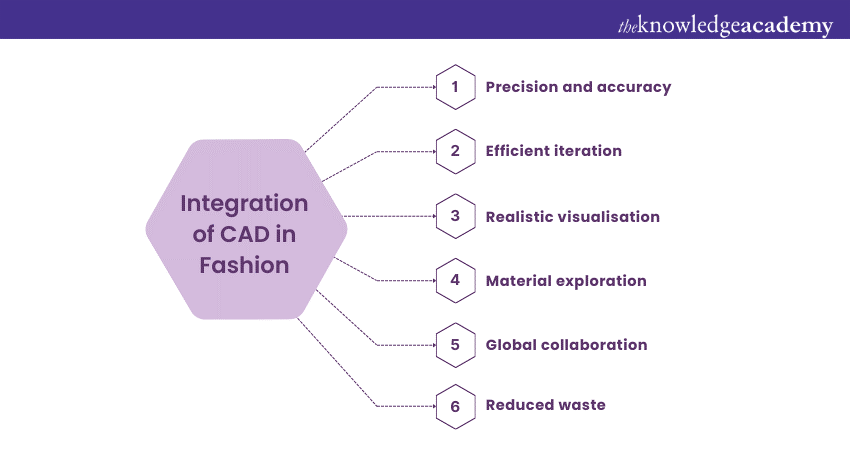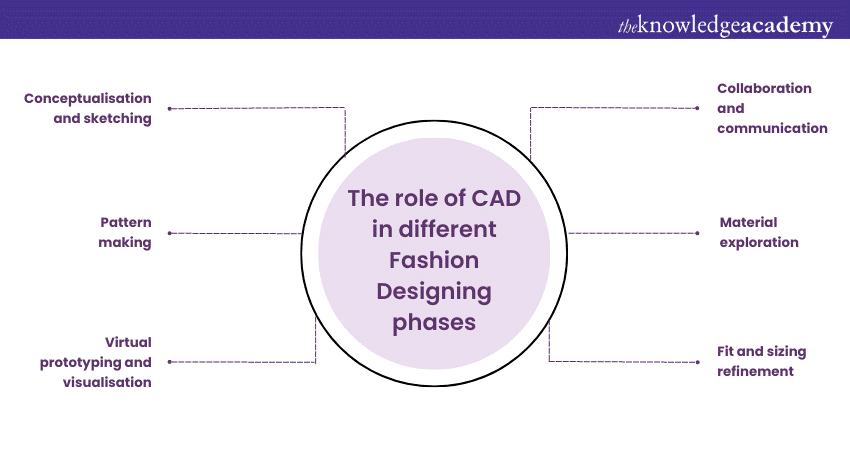We may not have the course you’re looking for. If you enquire or give us a call on +44 1344 203 999 and speak to our training experts, we may still be able to help with your training requirements.
Training Outcomes Within Your Budget!
We ensure quality, budget-alignment, and timely delivery by our expert instructors.

The field of Fashion Design has experienced a significant transformation with the integration of cutting-edge technology and artistic ingenuity, resulting in the use of CAD in Fashion Designing. This intriguing synergy between creativity and Computer-Aided Design (CAD) technology has transformed the way garments are conceptualised, crafted, and brought to life.
In this blog, we will understand "What is CAD in Fashion Designing" and explore the depths of this phenomenon; we'll uncover how CAD has seamlessly woven itself into the fabric of fashion, empowering designers with tools that transcend traditional limitations. From intricate sketches to virtual prototypes, CAD has redefined the boundaries of imagination, shaping the industry's present and illuminating the path toward an exhilarating, technologically driven future.
Table of contents
1) Understanding CAD in Fashion Designing
2) Benefits of CAD in Fashion Designing
3) CAD tools and software in Fashion Designing
4) The role of CAD in different Fashion Designing phases
5) Conclusion
Understanding CAD in Fashion Designing
Let's begin by understanding CAD in Fashion Designing; this section will focus on aspects central to the subject:
Evolution of Fashion Designing
The evolution of fashion design has been a captivating narrative of innovation and adaptation. The industry has undergone a paradigm shift from the meticulous hand-drawn sketches of yesteryears to the current era of virtual design studios. This evolution has been driven by the desire for precision, efficiency, and the ability to visualise designs in ways that transcend traditional methods.
Integration of CAD in Fashion
The integration of Computer-Aided Design (CAD) technology in the world of fashion has brought about a revolution that transcends traditional design boundaries. This fusion of artistry and technology has led to a myriad of benefits that have reshaped the fashion landscape in profound ways. Let's dive into the integral aspects of how CAD has seamlessly woven itself into the fabric of fashion:

a) Precision and accuracy: CAD tools offer unprecedented precision and accuracy that was once unattainable through manual methods. Designers can create intricate patterns, designs, and technical drawings with pixel-perfect precision, ensuring every detail is captured flawlessly.
b) Efficient iteration: The digital realm of CAD empowers designers to iterate and experiment with designs rapidly. This accelerates the design process as multiple variations can be explored in a fraction of the time it would take using traditional methods.
c) Realistic visualisation: With CAD, designers can visualise their creations in 3D, allowing for a lifelike representation of garments. Virtual prototyping enables designers to drape fabrics on virtual models, simulating how the final product will look and behave.
d) Material exploration: CAD provides the flexibility to experiment digitally with a broad range of fabrics and materials. Designers can test different textiles, colours, and textures to make informed decisions before creating physical prototypes.
e) Global collaboration: Geographical barriers are virtually eliminated with CAD. Designers, manufacturers, and stakeholders from around the world can collaborate seamlessly in a shared digital space. This fosters efficient communication and ensures that design concepts are accurately translated into production.
f) Reduced waste: The traditional fashion design process often involves creating physical prototypes that may only sometimes meet the designer's vision. CAD minimises waste by allowing designers to perfect designs digitally before moving to the production phase, reducing the need for excessive material usage.
g) Sustainability: As the fashion industry embraces sustainable practices, CAD plays a crucial role. Digital design reduces paper consumption and supports eco-friendly approaches, aligning with the industry's growing emphasis on environmental consciousness.
h) Customisation and personalisation: CAD empowers designers to create customised designs tailored to individual preferences. This level of personalisation enhances customer engagement and satisfaction, fostering brand loyalty.
i) Archiving and documentation: Digital CAD designs can be easily archived and retrieved. This facilitates future modifications, adaptations, or reproductions, ensuring designs remain accessible and relevant over time.
j) Educational advancement: CAD has become an essential tool in fashion education. Aspiring designers learn to navigate CAD software to visualise their creative ideas effectively, preparing them for the demands of a technologically driven industry.
Learn how to balance the colours, fabrics and patterns within their design, sign up for our Fashion Designing Training now!
Benefits of CAD in Fashion Designing
In the fast-paced world of fashion, where creativity knows no bounds, the integration of Computer-Aided Design (CAD) technology has emerged as a transformative force. This infusion of digital precision and innovation has yielded many benefits that have reshaped the fashion design landscape. Let's delve into the significant advantages that CAD brings to the forefront:
Enhanced Design precision
Precision lies at the heart of exceptional fashion design, and CAD technology is a virtual magnifying glass for designers. Every detail, from intricate patterns to seam placements, can be meticulously crafted with pixel-perfect accuracy. This precision ensures that the final product aligns seamlessly with the designer's vision, eliminating the imprecision that can arise from manual processes.
Efficient iteration and prototyping
Gone are the days of painstakingly crafting physical prototypes and making alterations through trial and error. CAD empowers designers to iterate rapidly by making instantaneous modifications to digital designs. This agile approach significantly speeds up the design process, allowing designers to experiment with many creative options without the constraints of time or resources.
Time and cost savings
In the competitive realm of fashion, time is of the essence. CAD accelerates the journey from concept to market by streamlining design iterations and reducing the need for physical prototypes. This efficiency translates to substantial cost savings, as fewer materials are wasted on iterations and prototypes that don't align with the designer's vision.
Sustainability in Design
As the fashion industry focuses on sustainability, CAD technology emerges as a sustainability ally. By enabling designers to perfect designs digitally, unnecessary material consumption is minimised. Additionally, reducing paper-based sketches and physical prototypes contributes to a greener design process, aligning with the industry's increasing emphasis on eco-conscious practices.
Exploration of complex Designs
Complex designs that involve intricate patterns, unique silhouettes, and innovative structures can be challenging to execute manually. CAD empowers designers to explore these complexities with ease. The digital canvas provides a playground for experimenting with intricate design elements that push the boundaries of traditional fashion.
Streamlined collaboration
CAD transcends geographical barriers by enabling seamless collaboration among designers, manufacturers, and stakeholders. Design concepts can be shared and visualised in real time, fostering effective communication and ensuring the final product reflects the designer's intent.
Gain knowledge and understanding of an interest, sign up for our Hobbies & Interests Training now!
CAD tools and software in Fashion Designing
In the fashion world, where innovation meets craftsmanship, integrating Computer-Aided Design (CAD) tools has been nothing short of revolutionary. These sophisticated digital companions have redefined the creative process, empowering designers to transcend traditional boundaries and explore uncharted design territories. Let's look into CAD tools and software, examining their roles and impact in the field of fashion designing:
2D CAD software
At the heart of many design processes lies the canvas of 2D CAD software. This digital realm allows designers to create flat sketches, technical drawings, and patterns with the precision that was once inconceivable through manual methods. Tools like Adobe Illustrator and CorelDRAW enable designers to bring their ideas to life on a virtual platform, facilitating the exploration of proportions, silhouettes, and intricate details with unparalleled accuracy.
3D CAD software
The evolution of fashion design has witnessed the transformation of flat sketches into three-dimensional realities through 3D CAD software. These tools elevate the design process by allowing designers to make virtual prototypes that can be manipulated and visualised from all angles. Software such as CLO, Browzwear, and Optitex enables designers to drape fabrics on digital avatars, offering a lifelike representation of how the garment will interact with movement and various fabrics.
Simulation and visualisation
CAD software goes beyond static images, enabling dynamic simulations and visualisations. Designers can simulate fabric behaviour, explore how garments respond to different poses, and even simulate runway walks. This not only aids in refining designs but also provides an opportunity to anticipate any potential design challenges before they manifest in physical prototypes.
Pattern making and grading
The precision required in pattern making is a cornerstone of garment construction. CAD tools streamline this process by enabling digital pattern creation and modification. Once a pattern is perfected, these tools facilitate grading, ensuring the design is seamlessly scaled to different sizes while maintaining proportions and fit.
The role of CAD in different Fashion Designing phases
The integration of Computer-Aided Design (CAD) technology has permeated every facet of the fashion design process, revolutionising how garments are conceived, developed, and brought to life. Here's a breakdown of how CAD plays a pivotal role in different phases of fashion designing:

Conceptualisation and sketching:
a) CAD tools empower designers to translate their creative ideas into digital sketches, offering a platform for experimentation without the constraints of traditional media.
b) Rapid iterations allow for quick adjustments, refining the design's elements before moving forward.
Pattern making:
a) CAD software streamlines pattern creation, ensuring precision and consistency in intricate designs.
b) Designers can manipulate patterns digitally, testing how they interact with different fabrics and proportions.
Virtual prototyping and visualisation:
a) CAD enables designers to create virtual prototypes by draping digital fabrics on 3D models.
b) This visualisation allows for a realistic assessment of how the garment looks and behaves in various situations.
Collaboration and communication:
a) CAD facilitates seamless communication between design teams, manufacturers, and stakeholders worldwide.
b) Digital designs can be shared instantaneously, reducing errors and misinterpretations.
Material exploration: Designers can experiment with an extensive range of digital fabrics and textures, understanding how different materials will impact the final product.
Fit and sizing refinement:
a) Digital prototypes can be manipulated to fit various body types and sizes, aiding in creating inclusive designs.
b) Virtual fitting sessions minimise the need for multiple physical prototypes.
Technical specifications: CAD software aids in generating technical specifications, including seam allowances, stitching details, and fabric information, ensuring accuracy in production.
Presentation and documentation:
a) CAD allows for the creation of comprehensive design portfolios and presentations.
b) Digital archives ensure that designs remain accessible for future reference and adaptations.

Conclusion
The integration of CAD in fashion design has ushered in a new era of innovation. Blending artistic expression with technological prowess, CAD offers a dynamic canvas for designers to redefine boundaries and realise their visions. Answering "What is CAD in fashion designing?" It's the gateway to limitless creativity and precision.
Gain knowledge on various techniques to obtain best image with ideal colour, sign up for our Photography Masterclass now!
Frequently Asked Questions
Upcoming Business Skills Resources Batches & Dates
Date
 Cake Decorating Getting Started Workshop
Cake Decorating Getting Started Workshop
Fri 14th Feb 2025
Fri 11th Apr 2025
Fri 13th Jun 2025
Fri 15th Aug 2025
Fri 10th Oct 2025
Fri 12th Dec 2025







 Top Rated Course
Top Rated Course


 If you wish to make any changes to your course, please
If you wish to make any changes to your course, please


